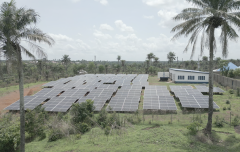Strengthening the mini-grid sector: Takeaways from the 7th Mini-grid Action Learning Event
The Africa Minigrid Developers Association and the World Bank recently convened over 300 stakeholders in Nairobi, Kenya for the 7th Mini-grid Action Learning Event. In addition to launching the World Bank’s Mini-grids for Half a Billion People report, the event was an opportunity to delve into the sector’s technical and economic challenges, exchange what is working, and collectively brainstorm innovative ways to move the sector forward.
While the theme of the event centred on scaling the mini-grid market, it also allowed for refreshingly frank discussions around the urgent need to ensure the sustainability of existing mini-grids, particularly across Africa. For example, mini-grid companies continue to face mounting political pressure regarding end-user tariffs, exacerbated by macro-economic circumstances and devaluing local currencies.
Below is a high-level summary of the learnings, trends and perspectives emerging from the event.
The debate over end-user tariffs: a crisis of affordability or perception?
Unsurprisingly, a key issue driving discussion was tariffs. In the early days of the mini-grid sector, end-user tariffs – the price paid by consumers per kilowatt hour – were benchmarked against the avoided costs for traditional fuels and modes of power. In many cases, this approach is even followed in the tariff calculator model that is submitted for regulatory or funding approvals.
But today, particularly in markets where we see an increasing number of mini-grids in operation, avoided costs are not the most commonly cited comparator, at least not by the customers themselves. Instead, consumers and politicians focus on how mini-grid electricity prices compare to those of the national grid, or between mini-grids themselves.
The concern raised is valid: why do we ask the most rural and remote communities to pay electricity tariffs far higher than those connected to the national grid? And while policy makers increasingly accept that benchmarking tariffs against those of the national grid is unfair, given the multitude of subsidies and bailouts afforded to national utility companies to keep the lights on, mini-grids cannot escape the comparison in public perception.
Hence a key discussion throughout the three days of the event was whether framing the issue of the comparatively high end-user tariffs is in fact a question of affordability or rather perception. And while the World Bank’s report targets a USD 0.20 tariff for mini-grids, the sector asked whether this will solve the problem, if continually benchmarked against the national utility tariffs?
We know what the answer is, why aren’t we working towards it?
Event participants agreed mini-grid companies should indeed be able to charge cost-reflective tariffs, otherwise the sector will collapse as we know it. To what extent the customer needs to pay that cost-reflective tariff was the question. And while we see new innovations in terms of funding mechanisms, particularly with results-based finance (RBF), as a way to support the sector through subsidies, these were often noted to be short- to medium-term solutions, while mini-grids are long-term investments in community infrastructure.
What was previously an “avoid at all costs” concept of a national uniform electricity tariff, has re-entered the discussion as perhaps the only solution to fully overcome the perception challenge. This was however positioned as an ideal scenario, for a somewhat utopic future. But one participant challenged the room: if we all agree it’s the answer, why are we not working towards it now? Kenya’s experience has showed progress in this direction, but we need further experience to leverage best-practices across various markets. Governments and donors need to come together to work towards subsidizing and in some cases even cross-subsidizing to improve equity in electricity pricing, regardless of technology, relieving the burden from project developers to absorb the variance.
Local currency financing remains the missing link
It was not surprising to hear that local currency financing is constantly referred to as the missing link in the financing landscape. Particularly in the context of macroeconomic challenges, the ability of mini-grid developers to access financing in the same currency that tariffs are paid is of utmost importance. While some partners such as the Global Energy Alliance for People and Planet (GEAPP) in Nigeria and Green Growth Fund have started to address this issue, there is still a large gap to fill. Given it is such a critical enabler, the finance community must come together to understand how to leverage local currency if the mini-grid sector is to prove sustainable through the current economic crisis, much less scale up in the future.
A healthy enabling environment starts with a clear national integrated electrification plan
When a panel of private sector mini-grid developers was asked what is the most important thing needed from government to make their mini-grid business grow, the answer was clear and reliable integrated electrification plans.
Developers cited delays and added costs caused by countries having multiple and sometimes conflicting electrification plans designating the communities for mini-grid electrification. Sometimes a developer will already have a project approved based on one plan, only to have a new electrification plan introduced and require new approvals. Ultimately what makes an integrated electrification plan effective is 1) it is backed by best-in-class data and based on a least-cost methodology 2) is driven by and politically accepted across all relevant Ministries and agencies/regulatory authorities, and 3) has a clear indication of longevity and timeline before revision.
The success of mini-grid policies and regulations lies in implementation capacity
Country-focused discussions acknowledged that a lot of effort has been put into developing strong and robust mini-grid regulations and policies across many markets in Africa. However, the capacity to implement these policies, meet approval timelines and provide the private sector with clear processes remains a bottleneck. The development support and technical assistance landscape therefore needs to shift with these needs to focus on building institutional and governance capacities, particularly with regulatory authorities in order to reduce delays driving up project development costs and ultimately the CAPEX.
Areas of convergence with the off-grid solar sector should be better leveraged
While many countries have implemented important import-tax exemptions, there remains ambiguity at the customs authority in many cases whether the products will be deemed exempt or not. Further, it was noted that over the last ca. 5 years, while the mini-grid sector was focused on perfecting mini-grid regulations, it was in fact the off-grid solar sector that led the charge in many countries on lobbying for import exemptions of solar products. The result has been that while panels and solar home kits are easily identifiable and therefore more often afforded exemptions, vital components for mini-grids such as batteries, cabling and electronics are often taxed at normal import rates.
Considering those in government with authority over mini-grids and off-grid solar are often the same people and departments, the decentralized renewable energy (DRE) sector is only doing itself a disservice by engaging in fragmented conversations across the electrification technologies. With strong sector associations such as GOGLA and AMDA, we should work to leverage the commonalities rather than differences to advance the DRE sector as a whole.
The road ahead
There is much to be hopeful about when it comes to mini-grids. The event showcased progress in business models leveraging scale, further analytical data emerging to better understand cost-drivers of mini-grid tariffs and the demand/price elasticity of mini-grid electricity, and significant improvements in enabling environments. There have also been some important learnings and a scaling up of RBF, as well as incremental progress on local currency financing. However, with a view to the speed and scale needed to address the energy access challenge, nuanced discussions on the topics above must be resolved by project developers, governments and financiers working together to ensure the sustainability of the sector.




